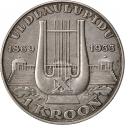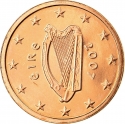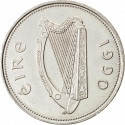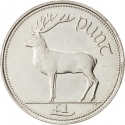You are about to finish your registration. Please check your mailbox (including spam folder). There should be a letter with a confirmation link. Check setting to make sure that your e-mail address is correct.
Send letter againDescription
The florin (2s) (Irish: flóirín) coin was a subdivision of the pre-decimal Irish pound, worth 1⁄10 of a pound. It was more commonly known as the two-shilling coin.
The original minting of the coin from 1928 until 1943 contained 75% silver, a higher content than the equivalent British coin. It is believed that this was done so that the new currency would not be seen as a poor substitute to the British currency which circulated alongside. The silver coins are quite noticeable as they have a more "whitish" look than the later cupronickel variety that were minted from 1951, also the silver coins wear less well.
The last florins were produced in 1968. When the currency was decimalised this coin continued to circulate alongside its replacement ten pence, and the florin was finally withdrawn from 1 June 1994 as a smaller ten pence coin was introduced.
Obverse

|
The Celtic harp is a triangular harp traditional to Brittany, Ireland, Scotland and Wales. In Ireland and Scotland it was a wire-strung instrument requiring great skill and long practice to play, and was associated with the Gaelic ruling class. In the Republic of Ireland, it appears on the coins and coat of arms. éIRe 1964 |
|---|---|
Reverse

|
Value, salmon (to the right). fLóirin |
| Edge |
Characteristics
| Material | Cupronickel |
| Weight | 11.3 g |
| Diameter | 28.6 mm |
| Thickness | 2.28 mm |
| Shape |
|
| Alignment | Medal |







